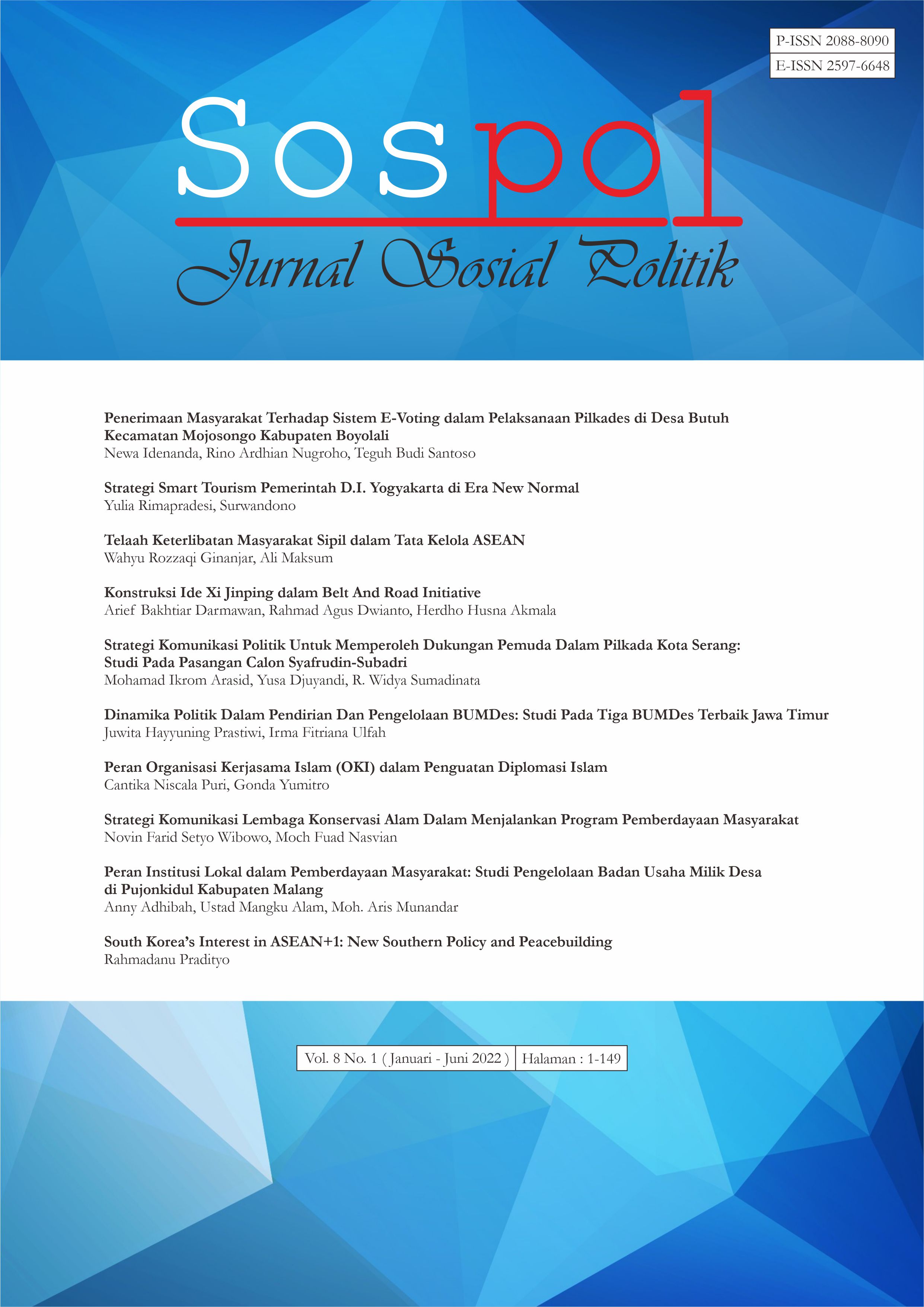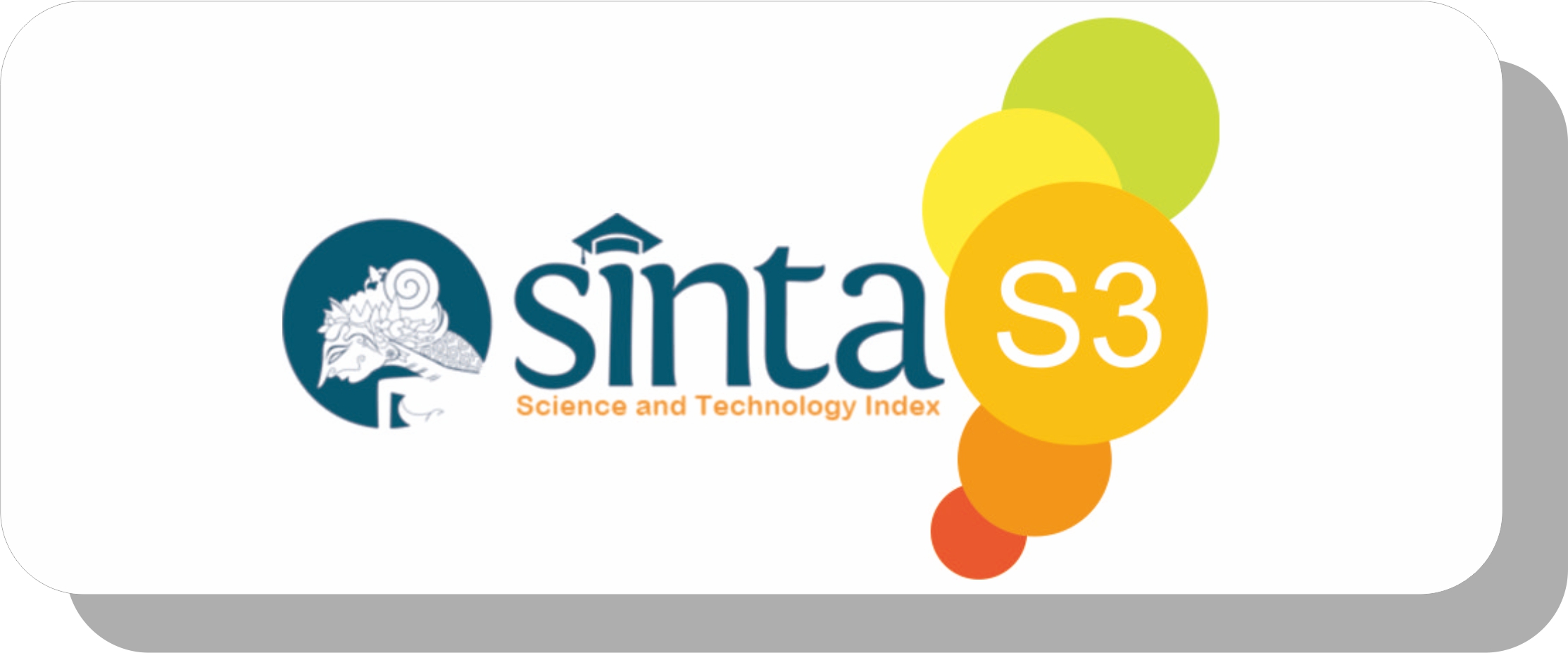Strategi Komunikasi Lembaga Konservasi Alam Dalam Menjalankan Program Pemberdayaan Masyarakat
DOI:
https://doi.org/10.22219/jurnalsospol.v8i1.20538Keywords:
Community Development, Communication Strategy, Collaboration, Conservation, TourismAbstract
The Foundation of Bhakti Alam Sendang Biru successfully developed conservation-based tourism in the most significant coastal area in Malang Regency. The foundation owned good communication with the society and slowly reduced the conflict among the community. Based on the context of regional tourism governance, this collaboration process requires effective communication strategies in carrying out the program to create synergy both between the management and the public. So it is interesting to explain the foundation's communication strategy to achieve a shared vision. It uses interviews and documentation as the primary data collection. The subject of this research is the foundation and internal and external stakeholders. The communication strategy carried out by the Foundation is to use a family approach by prioritizing personal and communal solutions. The Foundation also establishes two-way communication with community relations guidelines and promotes collaboration based on equal partnerships with the surrounding community. In planning activities, the Foundation always involves the community in a participatory manner. The communication strategy applied in carrying out the community empowerment program is by determining the right communicator, then the communication media used, the type of issue being communicated and the appropriate communicant. Through this strategy that has been implemented, there is community involvement in various aspects in supporting the Foundation's programs, either directly or indirectly. The community does not feel that they are merely objects but can take on the role of subjects who can jointly carry out community empowerment programs.
Downloads
References
Anderson, H., & Black, T. (2008). Multivariate Data Analysis. Pretince Hall.
Anggoro, M. . L. (2002). Teori dan Profesi Kehumasan. Bumi Aksara.
Buluamang, Y. M. ., & Handika, L. P. (2018). Strategi Komunikasi Pembangunan Dalam Pengembangan Pariwisata Development Communication Strategy In Developing The Tourism. Jurnal Penelitian Pers Dan Komunikasi Pembangungan, 22(2), 89–101.
Bungin, Burhan. (2015). Komunikasi Pariwisata. Jakarta: PT.Kencana Prenada Media Group
Cangara, Hafied. (2014). Perencanaan & Strategi Komunikasi. Jakarta : Rajawali Pers.
Effendy, Onong Uchjana. (2000). Ilmu Komunikasi. Teori dan Praktek. Bandung : PT Remaja Rosdakarya.
Fianto, A. Y. A., & Andrianto, N. (2022). Sustainable tourism development from the perspective of digital communication. Jurnal Studi Komunikasi, 6(1), 110-125.
Hatmansyah, Z. J., & Gusriani, R. (2005). Langkah Perjalanan PT arutmin Indonesia: Center for Community development. UMM Press.
Hidayati, R., & Rizqi, R. M. (2018). Strategi Komunikasi Pemasaran Pariwisata di Desa Wisata Rhee Loka Kabupaten Sumbawa (Studi Kasus Desa Wisata Pantai Gelora). Prosiding Seminar Nasional Manajemen Kerjasama Jurnal Manajemen Dan Bisnis, Manajemen Research Institute Universitas Teknologi Sumbawa, 4(3), 42–54. https://doi.org/https://doi.org/10.37673/jmb.v4i3.1334
Iriantara, Y. (2010). Community relations : konsep dan aplikasinya. Simbiosa Rekatama Media.
Isdianto, A., Asadi, M. A., Saputra, D. K., Musalina, F. P. A., Haykal, M. F., & Adibah, F. (2020). Pantai Kondang Merak : Bertahan Secara Ekosistem Atau Bertumbuh Secara Ekonomi. Jurnal Education and Development, 8(4). https://doi.org/https://doi.org/10.37081/ed.v8i4.2102
Liu-Lastres, B., Mariska, D., Tan, X., & Ying, T. (2020). Can post-disaster tourism development improve destination livelihoods? A case study of Aceh Indonesia. Journal of Destination Marketing & Management, 18. https://doi.org/https://doi.org/10.1016/j.jdmm.2020.100510.
Masyhadiah. (2017). Strategi Komunikasi Dinas Pariwisata dan Kebudayaan dalam Pengembangan Pariwisata di Kabupaten Mamuju. MITZAL: Jurnal Ilmu Pemerintahan & Ilmu Komunikasi, 2(1). https://doi.org/http://dx.doi.org/10.35329/mitzal.v2i1.268
Mclennan, S., & Banks, G. (2018). Reversing the lens: Why corporate social responsibility is not community development. Corporate Social Responsibility and Environmental Management. Corporate Social Responsibility and Environmental Management, 26(1), 117–126. https://doi.org/https://doi.org/10.1002/csr.1664
Mola, M. S. R., & Witarti, D. iswardani. (2020). Komunikasi Pemasaran Terpadu Dalam Pengembangan Pariwisata Ende Studi Kasus: Festival Danau Kelimutu. Communication, 11(1), 1–13. https://doi.org/http://dx.doi.org/10.36080/comm.v11i1.1004
Pratiwi, S. R., Dida, S., & Sjafirah, N. A. (2018). Strategi Komunikasi dalam Membangun Awareness Wisata Halal di Kota Bandung. Jurnal Kajian Komunikasi, 6(1), 78–90. https://doi.org/https://doi.org/10.24198/jkk.v6i1.12985
Ramanda, P., Hakim, L., & Pangestuti, E. (2019). Partisipasi Masyarakat dalam Pengelolaan Objek dan Daya Tarik Wisata Koridor Jalur Lintas Selatan Kabupaten Malang. Jurnal Profit, 13(4), 22–31. https://doi.org/https://doi.org/10.21776/ub.profit.2020.014.01.3
Revida, E., & Hidayatulloh, A. N. (2020). Teori Administrasi Publik. Yayasan Kita Menulis.
Rodiah, S., & Yusup, P. M. (2018). Strategi Komunikasi Dalam Pengembangan Desa Agro Wisata Di Kabupaten Pangandaran. Jurnal Signal, 6(2). https://doi.org/http://dx.doi.org/10.33603/signal.v6i2.1321
Ruslan, R. (2005). Manajemen Public Relations dan Media Komunikasi. Raja Grafindo Persada.
Salam, A. (2019). Internet of Things for Sustainable Community Development: Introduction and Overview. In: Internet of Things for Sustainable Community Development. Internet of Things (Technology, Communications and Computing). Springer. https://doi.org/https://doi.org/10.1007/978-3-030-35291-2_1
Sanchez, G., Guzman, A., & Ariza, R. (2020). “Sell” recommendations by analysts in response to business communication strategies concerning the Sustainable Development Goals and the SDG compass. Journal of Cleaner Production. https://doi.org/. https://doi.org/https://doi.org/10.1016/j.jclepro.2020.120194
Sara, I. M. S., Komang, A. K., & Jaya, I. W. K. (2020). Improving Economic Development Through The Establishment Of Village- Business Enterprises. Journal of Advanced Research in Dynamical and Control Systems - JARDCS, 12(6). https://doi.org/10.5373/JARDCS/V12I6/S20201269
Sedarmayanti. (2014). Membangun dan Mengembangkan Kebudayaan dan Industri Pariwisata. PT Refika Aditama.
Sjaida, Gheya Madinatu; Khadijah, Ute Lies Siti; Novianti, Evie. Stragtegi Komunikasi Pariwisata Taman Air Mancur Sri Baduga Melalui Media Instagram @Urangpurwakarta. Jurnal Master Pariwisata (JUMPA), [S.l.], p. 386 - 410, jan. 2021. ISSN 2502-8022
Singh, K., & Misra, M. (2021). The evolving path of CSR: toward business and society relationship. Journal of Economic and Administrative Sciences, 38(2), 304–332. https://doi.org/https://doi.org/10.1108/JEAS-04-2020-0052
Sugiyono. (2009). Metode Penelitian Kuantitatif Kualitatif dan ReyD. Alfabeta.
Tole, Rohiman. 2012. Peran Tokoh Masyarakat Suku Tengger Dalam Upaya Pengelolaan Kawasan Konservasi Hutan: Studi kasus Taman Nasional Bromo Tengger Semeru. Malang: Fakultas Pertanian dan Peternakan Universitas Muhammadiyah Malang
Werder, K. P., Nothhaft, H., Vercic, D., & Zerfass, A. (2018). Strategic Communication as an Emerging Interdisciplinary Paradigm, International Journal of Strategic Communication. International Journal of Strategic Communication, 12(4), 333–351. https://doi.org/DOI: 10.1080/1553118X.2018.1494181
Windiawati, D., Dwivayani, K. D., & Hairunnisa. (2020). Analisa Strategi Komunikasi Dinas pariwisata Kota Samarinda dalam Mempromosikan Potensi Wisata Kampung Tenun. Dunia Komunikasi, 8(2), 282–295. https://ejournal.ilkom.fisip-unmul.ac.id/site/?p=4150
Yanti. (2013). CSR Wisdom, Ragam Kepedu Subyek 2n Sosial dan Lingkungan Perusahaan. Percetakan Pohon Cahaya.
Downloads
Published
How to Cite
Issue
Section
License
Copyright (c) 2022 Novin Farid Setyo Wibowo, Moch Fuad Nasvian

This work is licensed under a Creative Commons Attribution-ShareAlike 4.0 International License.
Authors who publish with this journal agree to the following terms:
- Authors retain copyright and grant the journal right of first publication with the work simultaneously licensed under a Creative Commons Attribution-ShareAlike 4.0 International License that allows others to share the work with an acknowledgement of the work's authorship and initial publication in this journal.
- Authors are able to enter into separate, additional contractual arrangements for the non-exclusive distribution of the journal's published version of the work (e.g., post it to an institutional repository or publish it in a book), with an acknowledgement of its initial publication in this journal.
- Authors are permitted and encouraged to post their work online (e.g., in institutional repositories or on their website) prior to and during the submission process, as it can lead to productive exchanges, as well as earlier and greater citation of published work (See The Effect of Open Access).

This work is licensed under a Creative Commons Attribution-ShareAlike 4.0 International License.



















